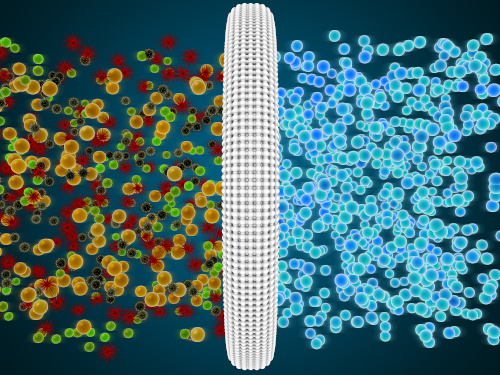Prior to the pandemic, many schools, colleges, and universities had indoor air quality challenges, but the past 18 months has brought a heightened awareness to a growing problem. Forty percent of the nation’s school systems need to replace at least half of their HVAC systems, according to a 2020 study by the Government Accountability Office.
Proper ventilation is a key prevention strategy for mitigating pathogens such as SARS-CoV-2, as well as reducing dust, allergens, and VOCs to improve health and well-being.
Many school, district, and higher education leaders are working to improve indoor air quality for their facilities and the government has offered funding to supplement those costs.
Most recently, the Department of Education introduced the American Rescue Plan (ARP), allocating funds which can be used specifically to improve indoor air quality in schools- specifically including system upgrades, filtering and purification, as well as inspection, testing, maintenance, repair, replacement, and upgrading of projects in school facilities.
The ARP provides $122 billion for the Elementary and Secondary Schools Emergency Relief (ESSER) Fund. The ESSER funds and Governors Emergency Education Relief (GEER) funds provided under earlier appropriations can also support this work. The original ESSER and GEER funds are available until 9/30/2022 while a second round of funding is available until 9/30/2023.
But there remains a lot of confusion about expectations of these devices; what they truly are – and aren’t – capable of. Here’s what you want to consider before installing these devices in your facility:
What do air purifiers really do?
Air purification is the improvement of indoor air quality by bringing in fresh air, filtering the air in a room at least 3 times every hour, and/or using advanced technologies such as BPI or PCO to actively reduce pollutants in the space.
Air purifiers were originally designed to eliminate volatile organic compounds (VOCs) and reduce odors such as those caused by bacterial and mold, pollen, dust, pet dander and other pollutants.
More recently, many companies are testing their air purifiers ability to specifically eliminate SARS-CoV-2, the virus that causes Covid-19. While many air purification devices have been proven effective at inactivating SARS-CoV-2 and other viruses, it’s important to note no device or filtration system is 100% effective and therefore air purification should be considered as one part of a larger cleaning and disinfecting plan.
When choosing a purifier, look for a device that also offers odor reducing technology.
Understanding acronyms
HEPA: The CDC endorses high-efficiency particulate air filters (HEPA) as the most efficient at capturing human generated virus particles. HEPA filters push air through fine mesh filters, removing dust and other particles without releasing any new potentially harmful materials into the air.
A true HEPA filter can remove at least 99.97% of particles in a lab setting. Be wary of HEPA-like or HEPA-type as they are not true HEPA and do not deliver these results. It’s also important to note that some viruses and VOCs are too small for even HEPA filters to trap, which is why multi-layered technologies- photocatalytic processes, UV lights and ions – are seen in the most effective air purification devices.
PCO: Photocatalytic oxidation photocatalytic oxidation (PCO) technology uses energy to turn moisture in the air into products that continuously clean your space.
BPI: Bipolar ionization creates a plasma of electrical charges, ionization removes allergens and other harmful pathogens from the breathing space, either by pushing them away or causing them to clump together and fall to the floor.
CADR: The clean-air delivery rate rating measures the speed that the purifier turns over the air in the room and removes dust, smoke and pollen. Look for a CADR of 300 or more.
Which one is right for us?
We’ve already established that a True HEPA filter is the first thing you want to look for, as well as a CADR of 300 or more.
One of the most common mistakes is choosing a purifier that’s not powerful enough for the space it’s cleaning. Make sure you install a device that’s designed for the size of the room or space you are trying to purify.
Recently the EPA took a stance advising that the use of ozone during the purification process should be limited to unoccupied spaces. Be sure to carefully read your owner’s manual regarding your device’s ozone emissions and operations.
Look for multiple technologies. Combining active air purification technologies such as PCO and BPI with a passive HEPA filter can further improve indoor air quality, speed up the purification process and destroy the smallest contaminants that the HEPA can’t capture.
Extend the life of your device
Once you’ve installed your air purification devices, maintenance is an important part of making sure they are operating to their highest ability.
Cleaning the external filters on a monthly basis keeps the internal mechanics clean and extends the overall life of the product.
If your device uses an active technology such as PCO or BPI, it likely has a UV light. You’ll also want to follow the manufacturer guidelines regarding replacing the UV light cell that controls the photocatalytic process annually or every two years to achieve maximum performance. You can usually return used cells to the manufacturer or dispose them in accordance with your local regulations.
One final note
Remember, the effectiveness of air purifiers in real-world situations will vary significantly from the controlled conditions in a laboratory. The air we breathe is constantly changing due to the conditions (including temperature and humidity) of the room we’re in, plus the materials and the people in the room.
Installing an air purification system is absolutely a great step to improve the space where your students and staff work, learn and play.
- 4 ways to encourage play in education - April 25, 2024
- CoSN IT Leader Spotlight: Lisa Higgins - April 25, 2024
- It’s time to pay student teachers - April 25, 2024


